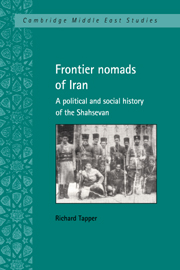Book contents
- Frontmatter
- Contents
- List of illustrations
- Preface
- Acknowledgments
- Note on transliteration
- Glossary
- 1 Writing tribal history
- PART I The Safavid state and the origins of the Shahsevan
- PART II The rise of the Shahsevan confederacy
- PART III The Shahsevan tribes in the Great Game
- PART IV The end of the tribal confederacy
- Appendices
- Bibliography
- Index of topics
- Index of places, peoples, persons, dynasties, parties, companies
- Index of authors quoted or discussed
- Index of tribal names
- Plate section
PART IV - The end of the tribal confederacy
Published online by Cambridge University Press: 05 March 2012
- Frontmatter
- Contents
- List of illustrations
- Preface
- Acknowledgments
- Note on transliteration
- Glossary
- 1 Writing tribal history
- PART I The Safavid state and the origins of the Shahsevan
- PART II The rise of the Shahsevan confederacy
- PART III The Shahsevan tribes in the Great Game
- PART IV The end of the tribal confederacy
- Appendices
- Bibliography
- Index of topics
- Index of places, peoples, persons, dynasties, parties, companies
- Index of authors quoted or discussed
- Index of tribal names
- Plate section
Summary
Life was good for the rebel tribes in the äshrarliq times; you wouldn't believe the destruction they caused. They would go and raid in other countries and bring back the plunder. They would not go at the command of the chiefs, no one knew or cared about what anyone else said or did; the chiefs should have come together and decided to stop the anarchy, but in fact they were the cause of it. A different sound came out of every young man's mouth; that was äshrarliq.
Hajji Vali Khan of Khalifali, interview in summer camp, August 1964.Fifty years ago was the time of rebellion (äshrarliq), there was no government (hökümät), no Shah, it was the time of the khans (khankhan). Whoever was powerful (güjlü) himself would pillage, plunder, steal and rob – that was khankhan. If a man had much influence (parti) and many horsemen, then he would get ahead. This continued until 1340 [1921–2], when Reza Shah became Shah of Iran and restored the government, then they collected the Shahsevan guns and the khankhans disappeared, the villages prospered, food was plentiful…
Amanollah Gobadi, interview in Pir-Evatlu village, August 1963.For some years after the closure of the Moghan frontier, no major political disturbances brought the Shahsevan tribes to the attention of the central government, or to that of the representatives of the two imperial powers who had earlier been interested in their situation.
- Type
- Chapter
- Information
- Frontier Nomads of IranA Political and Social History of the Shahsevan, pp. 217 - 220Publisher: Cambridge University PressPrint publication year: 1997



